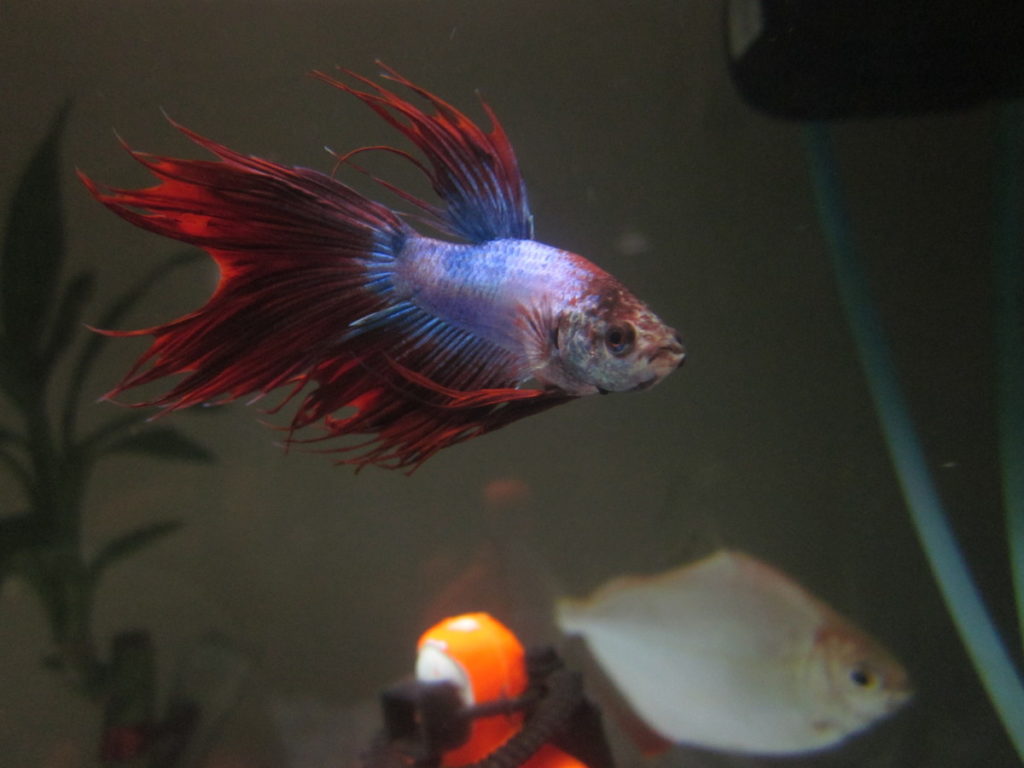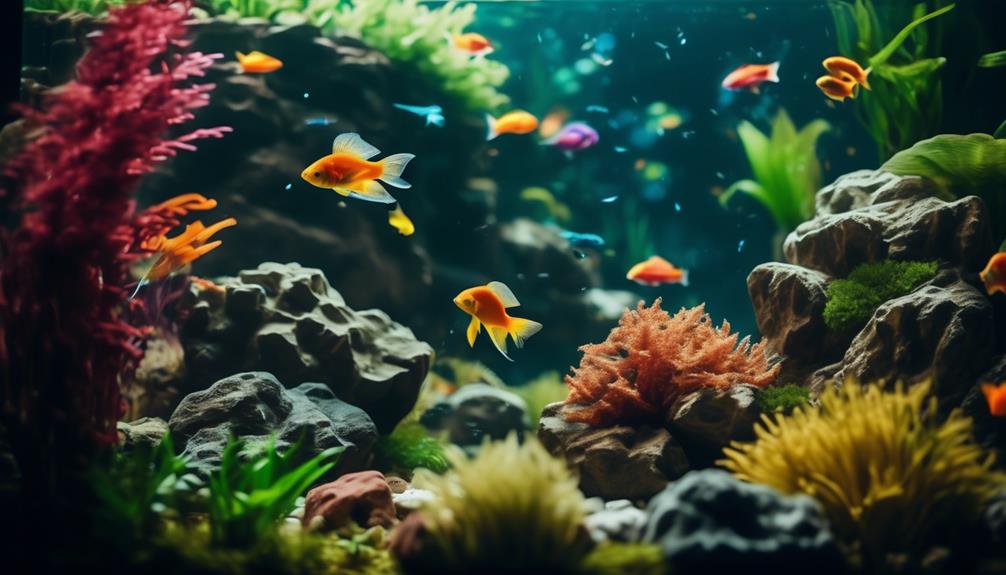
Are you tired of struggling to maintain a healthy and vibrant aquarium ecosystem?
Well, it just so happens that you've stumbled upon the perfect article to help you unlock the secrets of thriving aquariums.
From the crucial role of water quality to the importance of selecting the right fish and understanding their feeding habits, we will delve into the essential elements necessary for creating a balanced and thriving underwater world.
So, get ready to dive in and discover the key to creating a picturesque aquatic paradise that will leave your friends and family in awe.
Key Takeaways
- Monos, a type of brackish water fish, require specific care and conditions in order to thrive in an aquarium. This includes providing a large tank with plant cover, driftwood, and soft substrate.
- Corydoras, bottom-dwelling fish, are peaceful in nature and subsist on live, frozen, and flake foods. They do not eat live aquarium plants.
- Herbivorous fish should be fed herbivore flakes or pellets, along with dried algae and fresh vegetables. Proper feeding can prevent them from eating aquarium plants.
- Live plants in an aquarium contribute to the overall ecosystem by producing oxygen for the fish, utilizing nutrients to prevent algae growth, and requiring less maintenance compared to artificial plants.
Importance of Water Quality
To ensure a thriving aquarium ecosystem, it's crucial to prioritize the importance of water quality. The quality of the water in your aquarium directly affects the health and well-being of your fish, plants, and other aquatic organisms. Clean and properly balanced water is essential for their survival. Poor water quality can lead to stress, diseases, and even death of your aquatic pets.
It's important to regularly test the water parameters such as pH, ammonia, nitrite, and nitrate levels to ensure they're within the appropriate range. Regular water changes and proper filtration are also necessary to maintain optimal water quality.
Understanding the Nitrogen Cycle
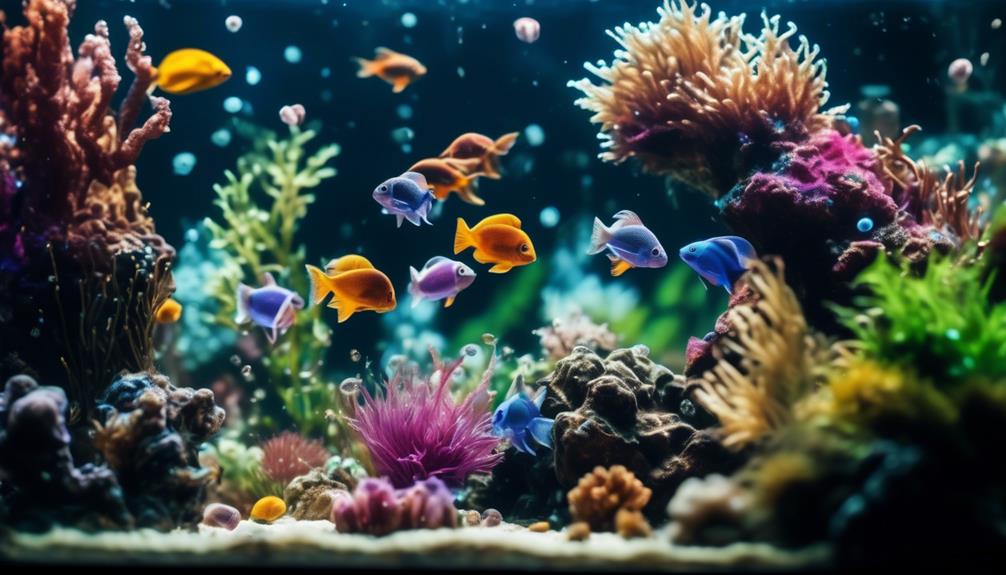
Maintaining optimal water quality in your aquarium begins with understanding the nitrogen cycle. This natural process is essential for the health and well-being of your aquatic ecosystem. The nitrogen cycle involves the conversion of ammonia, which is toxic to fish, into less harmful substances. Here's a breakdown of the nitrogen cycle:
| Stage | Description |
|---|---|
| 1. Ammonia | Fish waste and decaying organic matter produce ammonia. |
| 2. Nitrite | Beneficial bacteria convert ammonia into nitrite. |
| 3. Nitrate | Another group of bacteria convert nitrite into nitrate. |
| 4. Denitrification | In oxygen-depleted areas, bacteria convert nitrate into nitrogen gas, completing the cycle. |
To maintain a healthy nitrogen cycle, it is crucial to establish a colony of beneficial bacteria in your aquarium. These bacteria are responsible for breaking down ammonia and nitrite. Regular water testing will help you monitor the levels of ammonia, nitrite, and nitrate in your tank. By understanding and managing the nitrogen cycle, you can ensure a thriving and balanced aquarium ecosystem.
Selecting the Right Aquarium Size
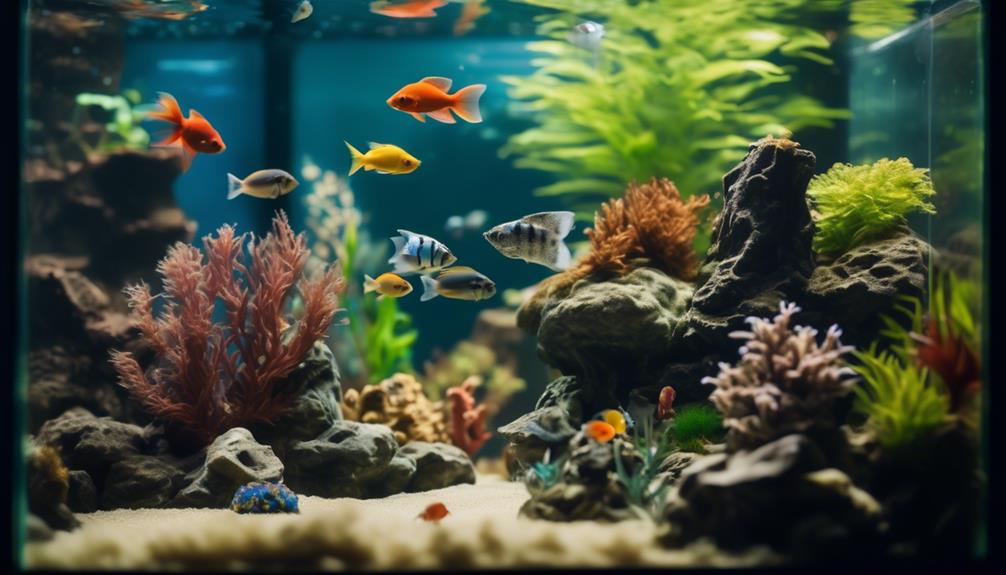
Choosing the appropriate aquarium size is crucial for creating a thriving and balanced ecosystem for your fish. When selecting the right aquarium size, consider the following:
- Fish Size: Different fish species have different space requirements. Larger fish, such as the Mono, need a larger aquarium, typically 50+ gallons, to comfortably swim and thrive.
- Number of Fish: The number of fish you plan to keep will also influence the size of the aquarium. A larger number of fish will require a larger tank to accommodate their needs.
Creating a Balanced Diet for Fish
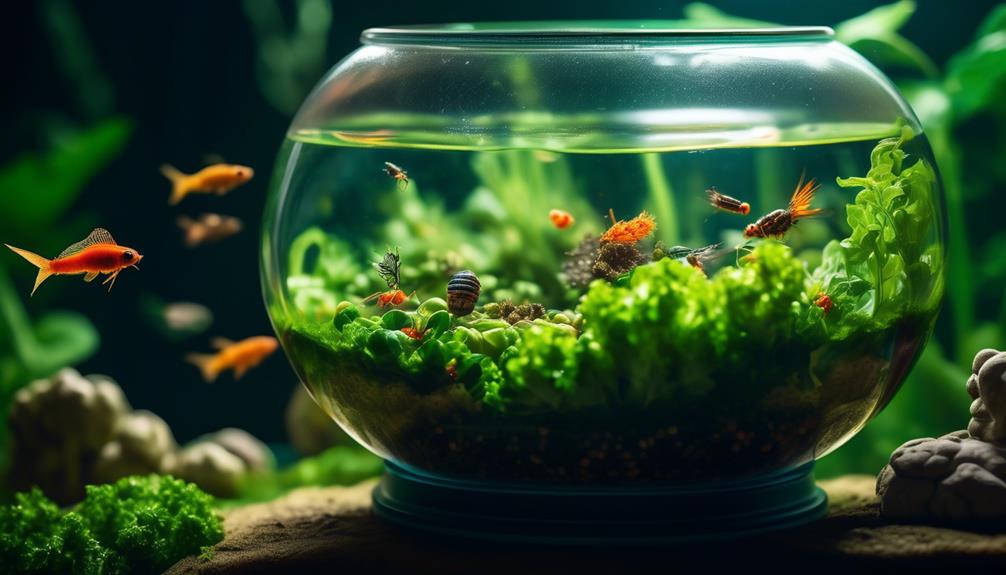
One key aspect of caring for your fish is ensuring they have a balanced diet. Providing a variety of foods is crucial to meet their nutritional needs. Here is a table that outlines some dietary options for different types of fish:
| Fish Type | Food Options |
|---|---|
| Mono Fish | Live foods, frozen foods, vegetable matter, pellets/flakes |
| Corydoras | Live food, frozen food, flake food |
| Herbivorous Fish | Herbivore flakes or pellets, dried algae, fresh vegetables |
It's important to note that some fish species may not eat aquarium plants but can still be harmful to them. For example, cichlids have a tendency to dig around in the substrate, damaging plant roots. Proper feeding of herbivorous fish can help prevent them from eating aquarium plants. Remember to research the behavior and dietary preferences of your fish species to ensure a balanced diet and the survival and growth of your aquarium plants.
The Role of Filtration Systems
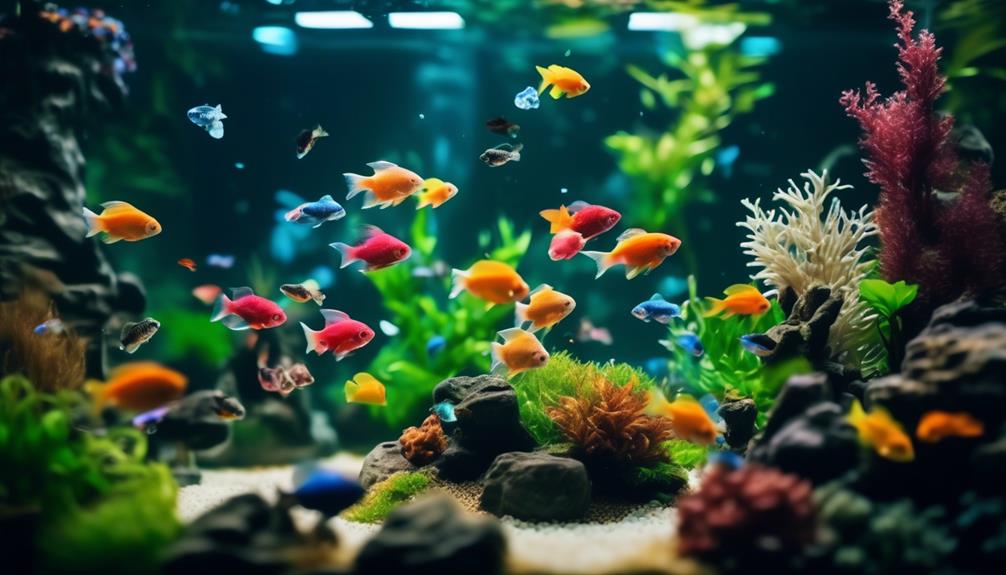
Filtration systems play a vital role in maintaining the health and balance of aquarium ecosystems. They help to keep the water clean and clear, removing harmful substances and ensuring a stable environment for your fish and plants.
Here are two key ways in which filtration systems contribute to the overall well-being of your aquarium:
- Mechanical Filtration: This type of filtration removes solid particles from the water, such as uneaten food, fish waste, and debris. It typically involves the use of a filter media, such as sponge or floss, which traps these particles and prevents them from circulating in the water column. By removing these substances, mechanical filtration helps to prevent water cloudiness and maintain optimal water quality.
- Biological Filtration: This type of filtration is responsible for breaking down harmful substances, such as ammonia and nitrite, into less toxic compounds. Beneficial bacteria colonize the filter media and convert these harmful substances into nitrate, which is less harmful to fish. Biological filtration is crucial for establishing a healthy nitrogen cycle in the aquarium, ensuring that the water remains safe for your aquatic inhabitants.
Proper Lighting for Aquarium Plants
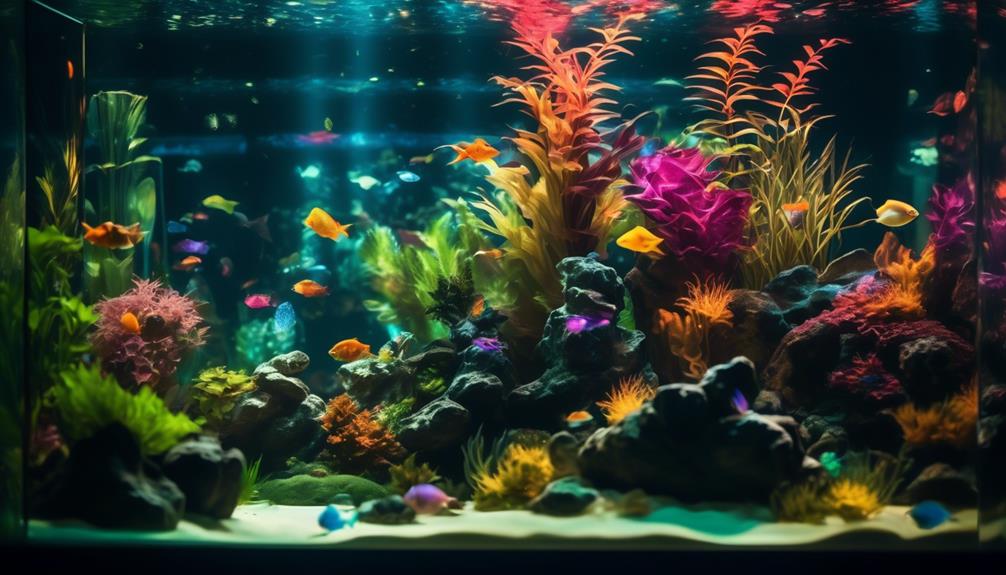
To ensure the healthy growth of your aquarium plants, it's crucial to provide proper lighting. Aquarium plants need light to photosynthesize and thrive. When choosing lighting for your aquarium, consider the specific needs of your plants.
Different species have different light requirements, so it's important to research and understand their specific needs. Generally, aquarium plants require a spectrum of light that includes both blue and red wavelengths. LED lights are a popular choice for aquariums as they provide a full spectrum of light and are energy efficient.
It's also important to consider the duration of light exposure. Most aquarium plants require around 8-10 hours of light per day. Be sure to monitor the intensity and duration of light to create optimal conditions for your plants to grow and flourish.
Choosing the Right Substrate
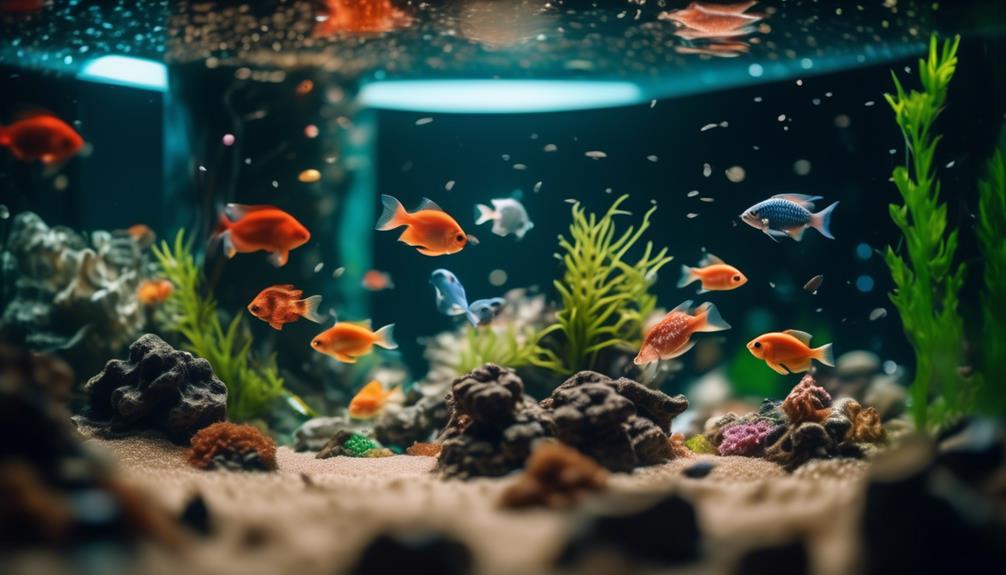
When selecting the substrate for your aquarium, it's important to consider the specific needs of your aquatic plants and fish. The substrate plays a crucial role in providing a stable environment for both plants and fish to thrive.
Here are some key factors to consider when choosing the right substrate:
- Composition:
- Gravel: Provides a natural look and allows for good water circulation.
- Sand: Ideal for bottom-dwelling fish like corydoras, as it mimics their natural habitat.
- Nutrient Content:
- Plant-specific substrates: Enriched with nutrients to promote healthy plant growth.
- Inert substrates: Suitable for tanks with low or no plant requirements.
Choosing the right substrate is essential for the overall health and well-being of your aquarium inhabitants. Consider the specific needs of your plants and fish to ensure a thriving ecosystem.
Maintaining a Stable Temperature
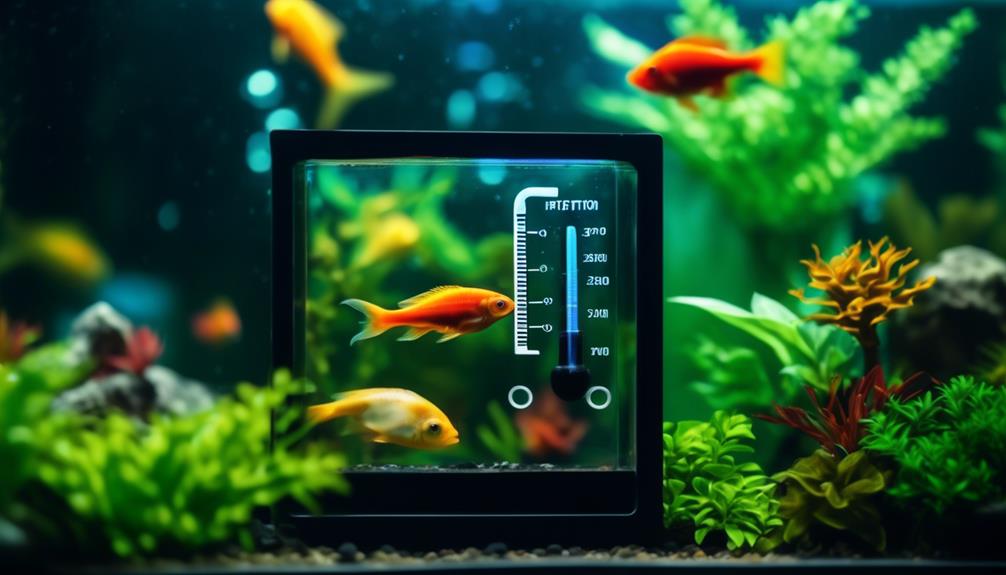
Maintaining a stable temperature in your aquarium is crucial for the well-being and health of your aquatic plants and fish. Fluctuations in temperature can cause stress to your aquarium inhabitants, leading to illness and even death. To ensure a stable temperature, it's important to choose the right heater for your tank size and type of fish.
Set the heater to the appropriate temperature range for your specific fish species and monitor it regularly. Additionally, consider the location of your aquarium. Keep it away from direct sunlight and drafts, as they can cause temperature fluctuations. Insulating your tank with a cover and using a thermometer will also help maintain a stable temperature.
Introducing Live Plants to the Aquarium
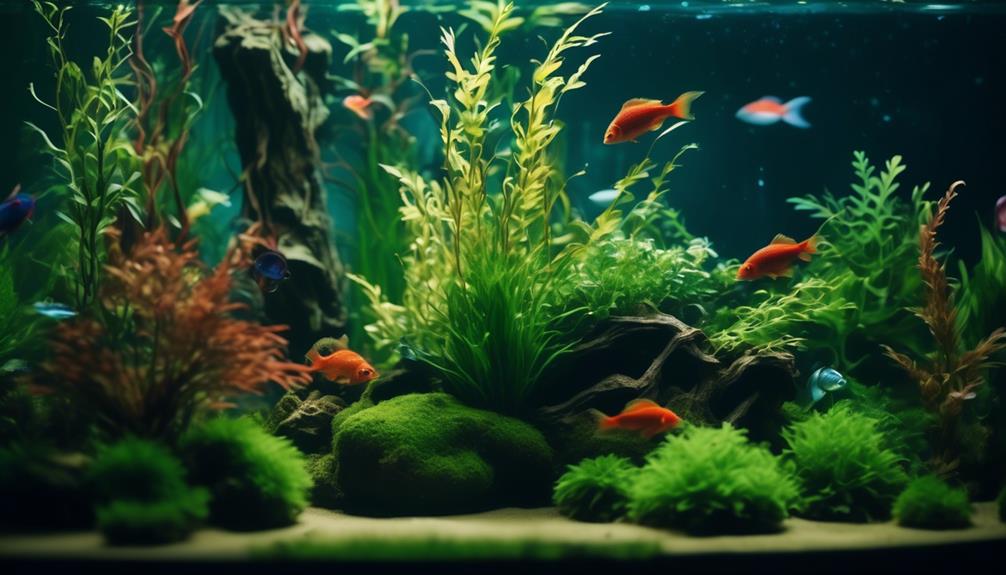
Live plants can enhance the beauty and functionality of your aquarium ecosystem. Introducing live plants to your aquarium can bring numerous benefits. Here's a breakdown of what you can expect:
- Aesthetics:
- Live plants add a natural and vibrant look to your aquarium, creating a visually appealing environment for your fish.
- They come in various shapes, sizes, and colors, allowing you to create unique and captivating underwater landscapes.
- Functionality:
- Live plants provide hiding places and shelter for your fish, reducing stress and promoting a sense of security.
- They help maintain water quality by absorbing nitrates and other harmful substances, creating a healthier environment for your fish.
Establishing a Healthy Fish Population
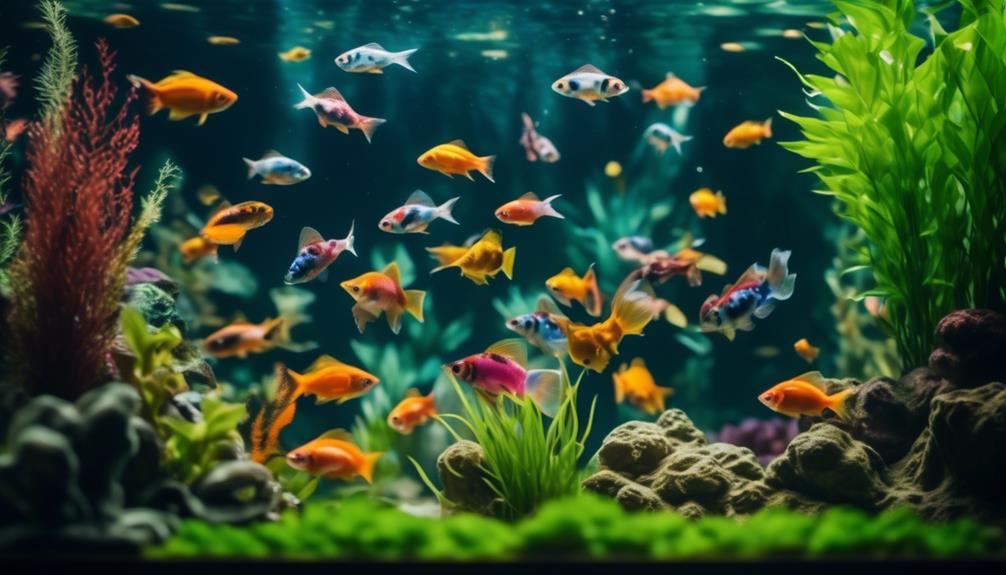
To establish a healthy fish population in your aquarium, it's important to carefully select compatible fish species. Consider factors such as size, temperament, and swimming region when choosing your fish.
For example, if you have a large aquarium, you might consider adding Mono Fish, which originate from estuaries and mangroves and prefer swimming in large shoals. If you have a planted tank, you could add Corydoras, bottom-dwelling fish that are peaceful in nature and don't eat live aquarium plants.
It's also crucial to consider the dietary preferences of the fish species you choose. Herbivorous fish, for instance, should be fed herbivore flakes or pellets, dried algae, and fresh vegetables to prevent them from eating aquarium plants.
Monitoring and Adjusting Water Parameters
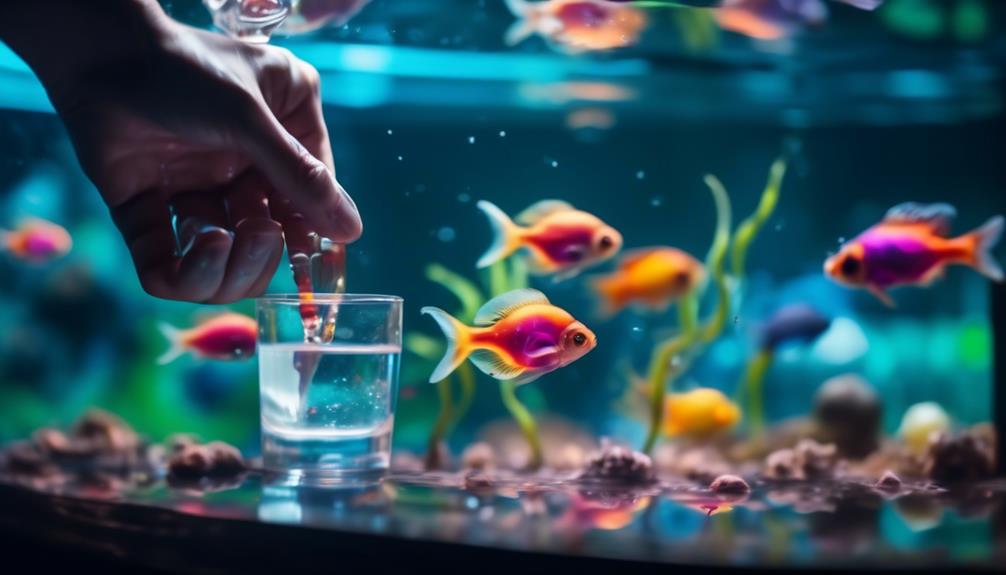
Regular monitoring and adjustment of water parameters is crucial for maintaining a healthy and thriving aquarium ecosystem. By regularly monitoring and adjusting water parameters, you can ensure that the conditions in your aquarium are optimal for your fish and plants.
Here are two key areas to focus on:
- Water Quality:
- Monitor and maintain proper pH levels to ensure the health and well-being of your aquatic life.
- Regularly test for ammonia, nitrite, and nitrate levels, and take appropriate measures to keep them within acceptable ranges.
- Temperature and Lighting:
- Use a reliable thermometer to monitor and maintain the temperature in your aquarium, as different species have different temperature preferences.
- Adjust the lighting intensity and duration to mimic natural daylight and provide the necessary light for your plants to thrive.
Preventing and Treating Common Fish Diseases
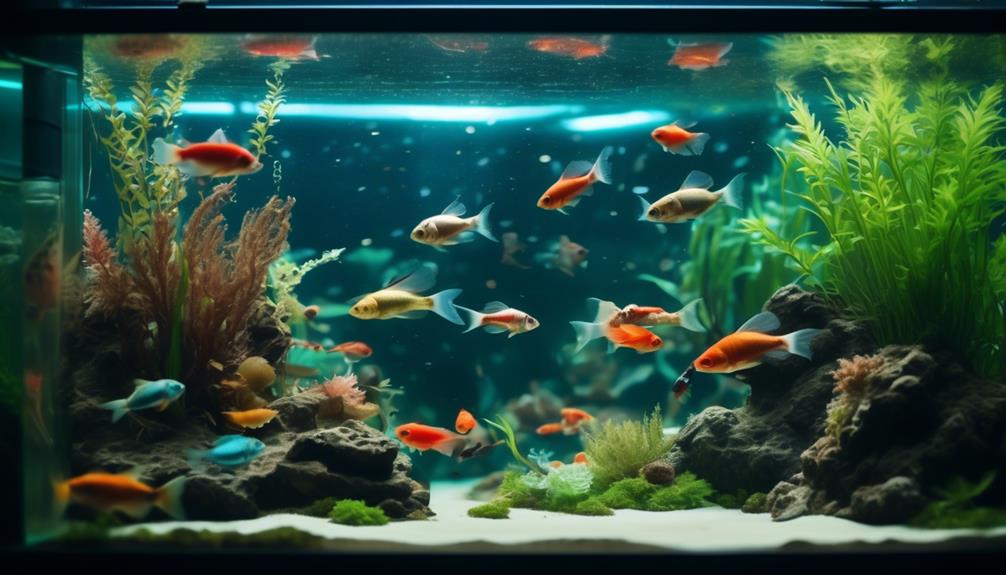
Maintaining optimal water parameters is essential for a thriving aquarium ecosystem, and now it's time to shift our focus to preventing and treating common fish diseases.
One of the most important steps in disease prevention is ensuring a clean and well-maintained aquarium. Regular water changes, proper filtration, and a balanced diet for your fish can help boost their immune systems and prevent diseases.
It's also important to quarantine any new fish before introducing them to the main tank to prevent the spread of potential diseases.
If you notice any signs of illness in your fish, such as changes in behavior, appetite, or physical appearance, it's crucial to act quickly. Research and identify the specific disease, then follow the appropriate treatment methods, which may include medications, water adjustments, or isolation.
Regular observation and proactive care are key to keeping your fish healthy and disease-free.
Managing Algae Growth in the Aquarium
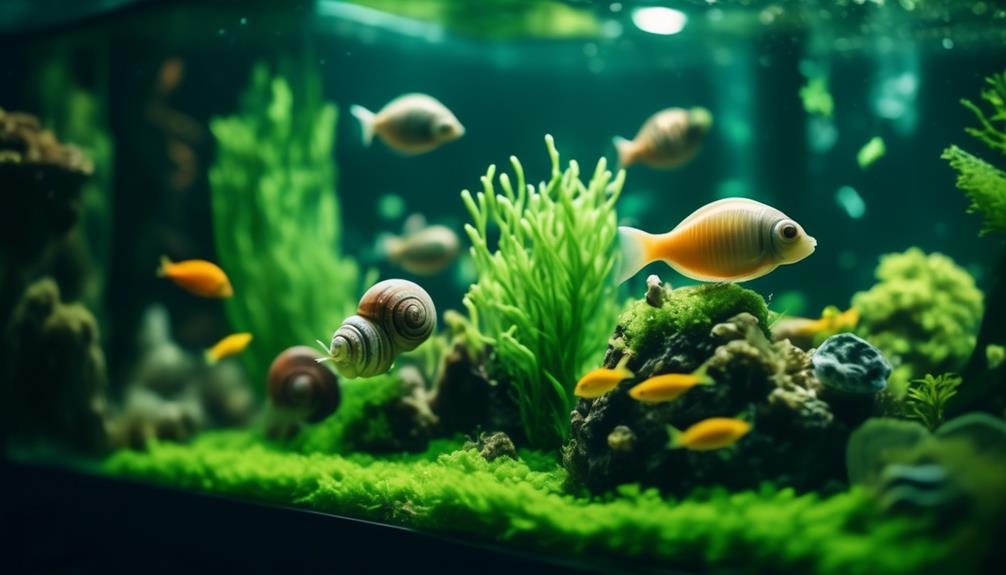
If you're struggling with algae growth in your aquarium, there are several effective methods you can employ to manage it. Here are two approaches you can try:
- Biological Control
- Introduce algae-eating fish, such as Siamese algae eaters or plecos, to help keep the algae population in check.
- Utilize live plants in your aquarium. They compete with algae for nutrients and can help prevent excessive algae growth.
- Physical Removal
- Use an algae scraper or brush to manually remove algae from the glass and decorations in your aquarium.
- Perform regular water changes to dilute excess nutrients that contribute to algae growth.
Tips for Cleaning and Maintenance
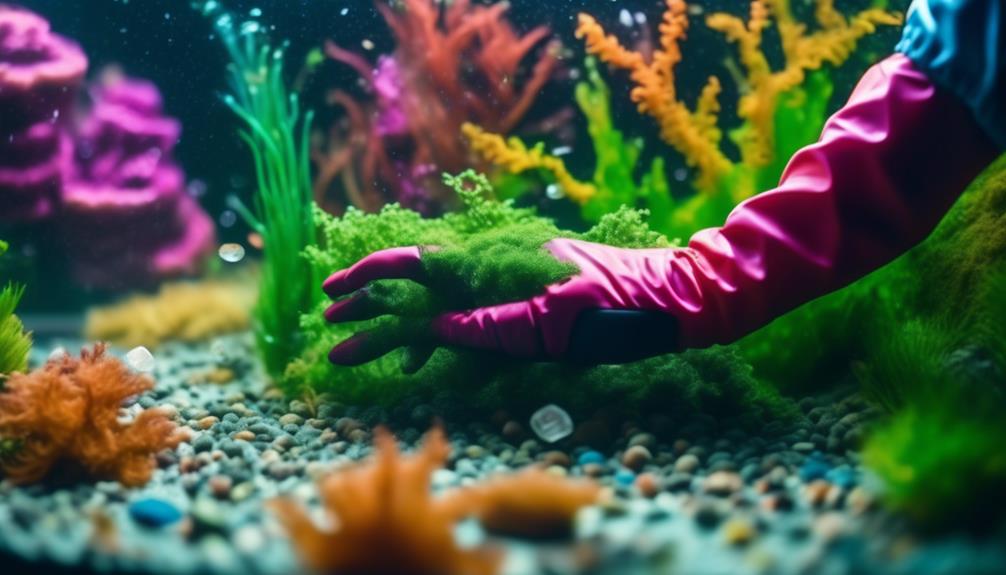
To keep your aquarium clean and well-maintained, follow these helpful tips:
| Cleaning and Maintenance Tips |
|---|
| 1. Perform regular water changes to remove waste and maintain water quality. |
| 2. Clean the aquarium glass with a non-abrasive sponge or algae scraper to remove algae buildup. |
| 3. Vacuum the gravel or substrate to eliminate debris and excess food. |
| 4. Trim and remove dead or decaying plant matter to prevent it from decomposing and polluting the water. |
| 5. Check and clean the filter regularly to ensure proper functioning and prevent clogging. |
Frequently Asked Questions
How Do I Choose the Right Type of Plants for My Aquarium?
To choose the right plants for your aquarium, consider the lighting and nutrient levels in your tank. Research different species to find ones that are compatible with your water conditions and the fish you have.
What Are Some Common Mistakes to Avoid When Introducing Live Plants to the Aquarium?
When introducing live plants to your aquarium, some common mistakes to avoid are not providing enough light or nutrients, overcrowding the tank, and not properly anchoring the plants in the substrate.
Can I Keep Herbivorous and Carnivorous Fish Together in the Same Tank?
No, it is not recommended to keep herbivorous and carnivorous fish together in the same tank. They have different dietary needs and behaviors that may lead to aggression or lack of proper nutrition.
How Often Should I Clean My Aquarium and What Is the Best Way to Do It?
You should clean your aquarium regularly to maintain a healthy ecosystem. The frequency depends on the size and stocking level of your tank. A general guideline is to perform partial water changes and clean the filter every 1-2 weeks.
What Are Some Natural Methods to Prevent and Control Algae Growth in the Aquarium?
To prevent and control algae growth in your aquarium, try natural methods like introducing algae-eating fish, reducing light exposure, maintaining proper water parameters, and regularly cleaning the tank. These steps will help keep your aquarium ecosystem thriving.
Conclusion
In conclusion, by understanding the importance of water quality, the nitrogen cycle, and proper feeding techniques, you can create a thriving aquarium ecosystem.
Selecting the right aquarium size, utilizing filtration systems, and monitoring water parameters are also crucial for maintaining a balanced environment.
Additionally, preventing and treating common fish diseases, as well as managing algae growth, will help ensure the health and longevity of your aquatic plants and animals.
With these tips for cleaning and maintenance, you can create a picturesque underwater paradise that will bring joy and beauty to your life.

